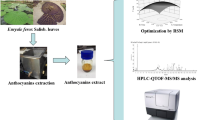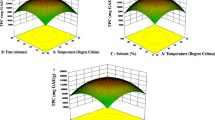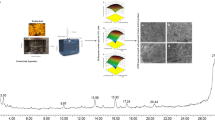Abstract
Extraction techniques are one way to separate bioactive compounds from agro-industrial material. Emerging technologies for the extraction of bioactive compounds, such as ultrasound-assisted extraction (UAE) and microwave-assisted extraction (MAE), are preferable to conventional extraction techniques because they are more efficient, spend less time, and are environmentally friendly. This study compared ultrasound (UAE) and microwave (MAE) assisted extraction techniques to recover anthocyanins from black rice bran. By optimizing using Box Behnken design, for UAE, 83.73% of the total anthocyanins (2.44 mg C3G/g) were recovered, using as parameters temperature 50°C, a frequency 380 W, and a solvent 60:40 (v/v) citric acid 0.1 M:ethanol. For MAE, it was possible to recover 81.44% of the total anthocyanins (2.37 mg C3G/g), using parameters temperature 55°C, citric acid 0.1M:ethanol (50:50, v/v), and a mass of 0.8 g (1:24, g/ml). Both techniques were considered ecologically green by the Green Certificate (A) and excellent methods by EcoScale (scores higher than 75). Anthocyanin-rich extracts did not show cytotoxicity for L292 cells (1000 μg/mL) and showed cytoprotection (> 92% using 500 μg/mL) when subjected to oxidative stress with H2O2. Both extracts showed technological potential as a natural dye and as an ingredient of nutraceutical products.
Graphical abstract




Similar content being viewed by others
References
Das AB, Goud VV, Das C (2017) Extraction of phenolic compounds and anthocyanin from black and purple rice bran (Oryza sativa L.) using ultrasound: a comparative analysis and phytochemical profiling. Ind Crops Prod 95:332–341. https://doi.org/10.1016/j.indcrop.2016.10.041
Leonarski E, Kuasnei M, Cesca K et al (2023) Black rice and its by-products: anthocyanin-rich extracts and their biological potential. Crit Rev Food Sci Nutr 0:1–19. https://doi.org/10.1080/10408398.2023.2211169
Halee A, Supavititpatana P, Ruttarattanamongkol K et al (2020) Optimisation of the microwave-assisted extraction of natural antioxidants from defatted black rice bran of Oryza sativa L.CV. homnin. J Microbiol Biotechnol Food Sci 9:1134–1140. https://doi.org/10.15414/JMBFS.2020.9.6.1134-1140
Luzardo-Ocampo I, Ramírez-Jiménez AK, Yañez J et al (2021) Technological applications of natural colorants in food systems: a review. Foods 10:1–34. https://doi.org/10.3390/foods10030634
Tena N, Martín J, Asuero AG (2020) State of the art of anthocyanins: antioxidant activity, sources, bioavailability, and therapeutic effect in human health. Antioxidants 9. https://doi.org/10.3390/antiox9050451
Lee J, Rennaker C, Wrolstad RE (2008) Correlation of two anthocyanin quantification methods: HPLC and spectrophotometric methods. Food Chem 110:782–786. https://doi.org/10.1016/j.foodchem.2008.03.010
Leonarski E, Kuasnei M, Moraes PAD et al (2023) Pressurized liquid extraction as an eco-friendly approach to recover anthocyanin from black rice bran. Innov Food Sci Emerg Technol 86. https://doi.org/10.1016/j.ifset.2023.103372
Fernandes TS, Ferreira GMD, Silva GA et al (2021) Extraction of anthocyanins from the byproduct and wastes of black rice production by ecofriendly method. Sep Sci Technol 00:1–12. https://doi.org/10.1080/01496395.2021.1992437
Perera CO, Alzahrani MAJ (2021) Ultrasound as a pre-treatment for extraction of bioactive compounds and food safety: a review. Lwt 142:111114. https://doi.org/10.1016/j.lwt.2021.111114
Shirsath SR, Sable SS, Gaikwad SG et al (2017) Intensification of extraction of curcumin from Curcuma amada using ultrasound assisted approach: effect of different operating parameters. Ultrason Sonochem 38:437–445. https://doi.org/10.1016/j.ultsonch.2017.03.040
Moreira SA, Alexandre EMC, Pintado M, Saraiva JA (2019) Effect of emergent non-thermal extraction technologies on bioactive individual compounds profile from different plant materials. Food Res Int 115:177–190. https://doi.org/10.1016/j.foodres.2018.08.046
Tena N, Asuero AG (2022) Up-to-date analysis of the extraction methods for anthocyanins: principles of the techniques, optimization, technical progress, and industrial application. Antioxidants 11. https://doi.org/10.3390/antiox11020286
Chemat F, Rombaut N, Sicaire AG et al (2017) Ultrasound assisted extraction of food and natural products. Mechanisms, techniques, combinations, protocols and applications. A review. Ultrason Sonochem 34:540–560. https://doi.org/10.1016/j.ultsonch.2016.06.035
Thakur R, Gupta V, Dhar P et al (2022) Ultrasound-assisted extraction of anthocyanin from black rice bran using natural deep eutectic solvents: Optimization, diffusivity, and stability. J Food Process Preserv 46. https://doi.org/10.1111/jfpp.16309
Coelho MC, Pereira RN, Rodrigues AS et al (2020) The use of emergent technologies to extract added value compounds from grape by-products. Trends Food Sci Technol 106:182–197. https://doi.org/10.1016/j.tifs.2020.09.028
Bagade SB, Patil M (2021) Recent advances in microwave assisted extraction of bioactive compounds from complex herbal samples: a review. Crit Rev Anal Chem 51:138–149. https://doi.org/10.1080/10408347.2019.1686966
Moirangthem K, Ramakrishna P, Amer MH, Tucker GA (2021) Bioactivity and anthocyanin content of microwave-assisted subcritical water extracts of Manipur black rice (Chakhao) bran and straw. Futur Foods 3:100030. https://doi.org/10.1016/j.fufo.2021.100030
Abdel-Aal E-SM, Akhtar H, Rabalski I, Bryan M (2014) Accelerated, microwave-assisted, and conventional solvent extraction methods affect anthocyanin composition from colored grains. J Food Sci 79:C138–C146. https://doi.org/10.1111/1750-3841.12346
Jha P, Das AJ, Deka SC (2017) Optimization of ultrasound and microwave assisted extractions of polyphenols from black rice (Oryza sativa cv. Poireton) husk. J Food Sci Technol 54:3847–3858. https://doi.org/10.1007/s13197-017-2832-0
Benvenutti L, Zielinski AAF, Ferreira SRS (2022) Pressurized aqueous solutions of deep eutectic solvent (DES): a green emergent extraction of anthocyanins from a Brazilian berry processing by-product. Food Chem X 13. https://doi.org/10.1016/j.fochx.2022.100236
Mónica Giusti M, Wrolstad RE (2001) Characterization and measurement of anthocyanins by UV-visible spectroscopy. Handb Food Anal Chem 2–2:19–31. https://doi.org/10.1002/0471709085.ch18
Vernon LS, Rudolf O, Rosa ML-R (1999) Analysis of total phenols and other oxidation substrates and antioxidants by means of folin-ciocalteu reagent. Methods Enzymol. 299:152–178
Brand-Williams W, Cuvelier ME, Berset C (1995) Use of a free radical method to evaluate antioxidant activity. LWT - Food Sci Technol 28:25–30. https://doi.org/10.1016/S0023-6438(95)80008-5
Re R, Pellegrini N, Proteggente A et al (1999) Development and characterisation of carbon nanotube-reinforced polyurethane foams. EMPA Act 26:51. https://doi.org/10.1016/S0891-5849(98)00315-3
Sajid M, Płotka-Wasylka J (2022) Green analytical chemistry metrics: a review. Talanta 238. https://doi.org/10.1016/j.talanta.2021.123046
Van Aken K, Strekowski L, Patiny L (2006) EcoScale, a semi-quantitative tool to select an organic preparation based on economical and ecological parameters. Beilstein J Org Chem 2:1–7. https://doi.org/10.1186/1860-5397-2-3
Teixeira RF, Benvenutti L, Burin VM et al (2021) An eco-friendly pressure liquid extraction method to recover anthocyanins from broken black bean hulls. Innov Food Sci Emerg Technol 67:102587. https://doi.org/10.1016/j.ifset.2020.102587
Boateng ID, Kumar R, Daubert CR et al (2023) Sonoprocessing improves phenolics profile, antioxidant capacity, structure, and product qualities of purple corn pericarp extract. Ultrason Sonochem 95:106418. https://doi.org/10.1016/j.ultsonch.2023.106418
Zhang Y, Lin Y, Huang L et al (2020) Composition, antioxidant, and anti-biofilm activity of anthocyanin-rich aqueous extract from purple highland barley bran. Lwt 125:109181. https://doi.org/10.1016/j.lwt.2020.109181
Rocha CB, Noreña CPZ (2020) Microwave-assisted extraction and ultrasound-assisted extraction of bioactive compounds from grape pomace. Int J Food Eng 16:1–10. https://doi.org/10.1515/ijfe-2019-0191
Celli GB, Ghanem A, Brooks MSL (2015) Optimization of ultrasound-assisted extraction of anthocyanins from haskap berries (Lonicera caerulea L.) using Response Surface Methodology. Ultrason Sonochem 27:449–455. https://doi.org/10.1016/j.ultsonch.2015.06.014
Albuquerque BR, Pinela J, Barros L et al (2020) Anthocyanin-rich extract of jabuticaba epicarp as a natural colorant: optimization of heat- and ultrasound-assisted extractions and application in a bakery product. Food Chem 316:126364. https://doi.org/10.1016/j.foodchem.2020.126364
Dranca F, Oroian M (2016) Optimization of ultrasound-assisted extraction of total monomeric anthocyanin (TMA) and total phenolic content (TPC) from eggplant (Solanum melongena L.) peel. Ultrason Sonochem 31:637–646. https://doi.org/10.1016/j.ultsonch.2015.11.008
Pinela J, Prieto MA, Pereira E et al (2019) Optimization of heat- and ultrasound-assisted extraction of anthocyanins from Hibiscus sabdariffa calyces for natural food colorants. Food Chem 275:309–321. https://doi.org/10.1016/j.foodchem.2018.09.118
de Sabino LBS, Filho EGA, Fernandes FAN et al (2021) Optimization of pressurized liquid extraction and ultrasound methods for recovery of anthocyanins present in jambolan fruit (Syzygium cumini L.). Food Bioprod Process 127:77–89. https://doi.org/10.1016/j.fbp.2021.02.012
Routray W, Orsat V (2012) Microwave-assisted extraction of flavonoids: a review. Food Bioprocess Technol 5:409–424. https://doi.org/10.1007/s11947-011-0573-z
Jafari SM, Mahdavee Khazaei K, Assadpour E (2019) Production of a natural color through microwave-assisted extraction of saffron tepal’s anthocyanins. Food Sci Nutr 7:1438–1445. https://doi.org/10.1002/fsn3.978
Zheng X, Xu X, Liu C et al (2013) Extraction characteristics and optimal parameters of anthocyanin from blueberry powder under microwave-assisted extraction conditions. Sep Purif Technol 104:17–25. https://doi.org/10.1016/j.seppur.2012.11.011
Izirwan I, Munusamy TD, Hamidi NH, Sulaiman SZ (2020) Optimization of microwave-assisted extraction of anthocyanin from Clitoria ternatea flowers. Int J Mech Eng Robot Res 9:1246–1252. https://doi.org/10.18178/ijmerr.9.9.1246-1252
Lao F, Giusti MM (2018) Extraction of purple corn (Zea mays L.) cob pigments and phenolic compounds using food-friendly solvents. J Cereal Sci 80:87–93. https://doi.org/10.1016/j.jcs.2018.01.001
Zielinski AAF, del Sanchez-Camargo AP, Benvenutti L et al (2021) High-pressure fluid technologies: recent approaches to the production of natural pigments for food and pharmaceutical applications. Trends Food Sci Technol 118:850–869. https://doi.org/10.1016/j.tifs.2021.11.008
Ashitha GN, Prince M V., Sanjay P (2020) Microwave assisted extraction of anthocyanin from Hibiscus rosa-sinensis. J Pharmacogn Phytochem 9:1418–1424. https://doi.org/10.22271/phyto.2020.v9.i2w.11047
Horžić D, Jambrak AR, Belščak-Cvitanović A et al (2012) Comparison of conventional and ultrasound assisted extraction techniques of yellow tea and bioactive composition of obtained extracts. Food Bioprocess Technol 5:2858–2870. https://doi.org/10.1007/s11947-012-0791-z
Mozafari L, Cano-Lamadrid M, Martínez-Zamora L et al (2023) Effect of ultrasound-assisted extraction with probe or bath on total phenolics from tomato and lemon by-products. In: Foods 2023. MDPI, Basel Switzerland, p 30
Ito VC, Lacerda LG (2019) Black rice (Oryza sativa L.): a review of its historical aspects, chemical composition, nutritional and functional properties, and applications and processing technologies. Food Chem 301:125304. https://doi.org/10.1016/j.foodchem.2019.125304
Laokuldilok T, Shoemaker CF, Jongkaewwattana S, Tulyathan V (2011) Antioxidants and antioxidant activity of several pigmented rice brans. J Agric Food Chem 59:193–199. https://doi.org/10.1021/jf103649q
Chañi-Paucar LO, Silva JWL, Maciel MIS, de Lima VLAG (2021) Simplified process of extraction of polyphenols from agroindustrial grape waste. Food Sci Technol 41:723–731. https://doi.org/10.1590/fst.31120
Wang B, Yang S, Xu L et al (2022) Evaluation study on extraction of anthocyanins from red cabbage using high pressure CO2 + H2O: a fuzzy logic model and metabolomic analysis. Sustain 14. https://doi.org/10.3390/su14031369
Agcam E, Akyıldız A, Kamat S, Balasubramaniam VM (2021) Bioactive compounds extraction from the black carrot pomace with assistance of high pressure processing: an optimization study. Waste Biomass Valoriz 12:5959–5977. https://doi.org/10.1007/s12649-021-01431-z
Jiang T, Mao Y, Sui L et al (2019) Degradation of anthocyanins and polymeric color formation during heat treatment of purple sweet potato extract at different pH. Food Chem 274:460–470. https://doi.org/10.1016/j.foodchem.2018.07.141
Wang W, Jung J, Tomasino E, Zhao Y (2016) Optimization of solvent and ultrasound-assisted extraction for different anthocyanin rich fruit and their effects on anthocyanin compositions. LWT 72:229–238. https://doi.org/10.1016/j.lwt.2016.04.041
Setyaningsih W, Saputro IE, Palma M, Barroso CG (2016) Pressurized liquid extraction of phenolic compounds from rice (Oryza sativa) grains. Food Chem 192:452–459. https://doi.org/10.1016/j.foodchem.2015.06.102
Das AB, Goud VV, Das C (2018) Extraction and characterization of phenolic content from purple and black rice (Oryza sativa L) bran and its antioxidant activity. J Food Meas Charact 12:332–345. https://doi.org/10.1007/s11694-017-9645-8
Finocchiaro F, Ferrari B, Gianinetti A (2010) A study of biodiversity of flavonoid content in the rice caryopsis evidencing simultaneous accumulation of anthocyanins and proanthocyanidins in a black-grained genotype. J Cereal Sci 51:28–34. https://doi.org/10.1016/j.jcs.2009.09.003
Armenta S, Garrigues S, de la Guardia M (2015) The role of green extraction techniques in Green Analytical Chemistry. TrAC - Trends Anal Chem 71:2–8. https://doi.org/10.1016/j.trac.2014.12.011
Gallart-Mateu D, Cervera ML, Armenta S, De La Guardia M (2015) The importance of incorporating a waste detoxification step in analytical methodologies. Anal Methods 7:5702–5706. https://doi.org/10.1039/c5ay01202c
Espino M, de los Fernández MÁ, FJV G et al (2018) Green analytical chemistry metrics: towards a sustainable phenolics extraction from medicinal plants. Microchem J 141:438–443. https://doi.org/10.1016/j.microc.2018.06.007
Abd-Elsalam HAH, Gamal M, Naguib IA et al (2021) Development of green and efficient extraction methods of quercetin from red onion scales wastes using factorial design for method optimization: a comparative study. Separations 8. https://doi.org/10.3390/separations8090137
Deneyer A, Ennaert T, Sels BF (2018) Straightforward sustainability assessment of sugar-derived molecules from first-generation biomass. Curr Opin Green Sustain Chem 10:11–20. https://doi.org/10.1016/j.cogsc.2018.02.003
ISO 10993-5:2009 (2009) International Organization for Standardization ISO10993-5:2009. Biological evaluation of medical devices — Part 5: Tests for in vitro cytotoxicity
Aprodu I, Milea SA, Anghel RM et al (2019) New functional ingredients based on microencapsulation of aqueous anthocyanin-rich extracts derived from black rice (Oryza sativa L.). Molecules 24:1–14. https://doi.org/10.3390/molecules24183389
Leonarski E, Cesca K, de Oliveira D, Zielinski AAF (2022) A review on enzymatic acylation as a promising opportunity to stabilizing anthocyanins. Crit Rev Food Sci Nutr:1–20. https://doi.org/10.1080/10408398.2022.2041541
Guimarães M, Mateus N, De Freitas V, Cruz L (2018) Improvement of the color stability of cyanidin-3-glucoside by fatty acid enzymatic acylation. J Agric Food Chem 66:10003–10010. https://doi.org/10.1021/acs.jafc.8b03536
Oancea S (2021) A review of the current knowledge of thermal stability of anthocyanins and approaches to their stabilization to heat. Antioxidants 10. https://doi.org/10.3390/antiox10091337
Cheok CY, Ragunathan A (2022) Anthocyanin degradation kinetics and thermodynamic analysis of Hibiscus rosa-sinensis L. Clitoria ternatea L. and Hibiscus sabdariffa L. Prog. Energy Environ 19:1–12. https://doi.org/10.37934/progee.19.1.112
Condurache NN, Croitoru C, Enachi E et al (2021) Eggplant peels as a valuable source of anthocyanins: extraction, thermal stability and biological activities. Plants 10:1–17. https://doi.org/10.3390/plants10030577
Junior ENM, Martins MG, Pereira GA et al (2023) Stability kinetics of anthocyanins of grumixama berries (Eugenia brasiliensis Lam.) during thermal and light treatments. Foods 12:565. https://doi.org/10.3390/foods12030565
Acknowledgements
The authors are grateful to the Brazilian agencies, CNPq (Conselho Nacional de Desenvolvimento Científico e Tecnológico), CAPES-PRINT (Project numbers 88887.310560/2018-00 and 88887.310727/2018-00).
Data availability statement
The data that support the findings of this study are available from the corresponding author upon reasonable request.
Author information
Authors and Affiliations
Contributions
E.L.: conceptualization, methodology, formal analysis, data curation, writing—review and editing. M.K.: conceptualization, methodology, formal analysis, data curation, writing—review and editing. E.H.S: conceptualization, methodology, formal analysis. L.B.: formal analysis. P.A.D.M.: formal Analysis. K.C.: writing—original draft, investigation, visualization, supervision. D.O.: investigation, resources, writing—original draft, visualization, supervision, project administration. A.A.F.Z.: investigation, resources, writing—original draft, visualization, supervision, project administration
Corresponding author
Ethics declarations
Ethical approval
Not applicable
Conflict of interest
The authors declare no competing interests.
Additional information
Publisher’s Note
Springer Nature remains neutral with regard to jurisdictional claims in published maps and institutional affiliations.
Supplementary information
ESM 1
(DOCX 55 kb)
Rights and permissions
Springer Nature or its licensor (e.g. a society or other partner) holds exclusive rights to this article under a publishing agreement with the author(s) or other rightsholder(s); author self-archiving of the accepted manuscript version of this article is solely governed by the terms of such publishing agreement and applicable law.
About this article
Cite this article
Leonarski, E., Kuasnei, M., dos Santos, E.H. et al. Ultrasound and microwave-assisted extractions as green and efficient approaches to recover anthocyanin from black rice bran. Biomass Conv. Bioref. (2024). https://doi.org/10.1007/s13399-024-05479-4
Received:
Revised:
Accepted:
Published:
DOI: https://doi.org/10.1007/s13399-024-05479-4




